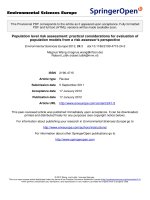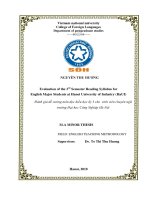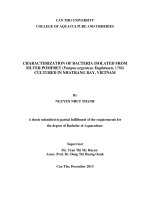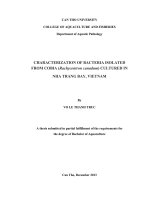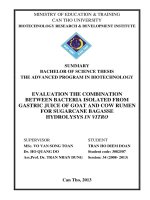Evaluation of bacteria isolated from wheat Rhizosphere for plant growth promoting attributes and antagonistic activity
Bạn đang xem bản rút gọn của tài liệu. Xem và tải ngay bản đầy đủ của tài liệu tại đây (481.24 KB, 10 trang )
Int.J.Curr.Microbiol.App.Sci (2019) 8(4): 86-95
International Journal of Current Microbiology and Applied Sciences
ISSN: 2319-7706 Volume 8 Number 04 (2019)
Journal homepage:
Original Research Article
/>
Evaluation of Bacteria Isolated from Wheat Rhizosphere for Plant Growth
Promoting Attributes and Antagonistic Activity
Sandeep Saini1*, Zeeshan Ahmad Faridi1, Akanksha Verma1, Ajaya T. Das,
Rimpa Manna1, Ankita Verma2 and C.B.S. Dangi1
1
Department of Biotechnology, Faculty of Science, RKDF University,
Bhopal, Madhya Pradesh-462033, India
2
Department of Microbiology, Pragya Mahavidyalaya, Pachore,
Madhya Pradesh-465683, India
*Corresponding author
ABSTRACT
Keywords
PGPR, Wheat,
Rhizopshere,
Antagonism
Article Info
Accepted:
04 March 2019
Available Online:
10 April 2019
Plant growth promoting rhizobacteria are the soil bacteria present around the rhizopshere
and are involved in promoting plant growth and development via different mechanisms. In
order to promote sustainable agriculture, the present investigations were undertaken to
screen the PGPR isolates from the plant rhizosphere. A total of eight rhizobacteria were
isolated from the wheat plant rhizosphere. The biochemical tests such as Catalase test,
oxidase test, nitrate reduction, Citrate Utilization, Urease test, Gelatinase test and
carbohydrate utilization carried out for phenotypic identification of isolates. Based on
functional characteristics, few isolates were found positive for siderophore, production,
Phosphate soulubilization potential and indole production. Subsequently, these isolates
also showed in vitro antagonistic activity against Macrophomina phaseolina, Sclerotinia
sclerotiorum, Sclerotium rolfsii, Fusarium sp. Therefore, the present study suggested that
isolated bacteria showed PGPR potential and biocontrol ability which can be used for
biofertilizers as well as biocontrol agents. Consequently, these isolates can be further
evaluated under in situ soil microcosm experiments.
the basis of their effects on plant growth
(Dobbelaere et al., 2003). Among the
different groups, Plant growth promoting
rhizobacteria (PGPR) are a group of
beneficial bacteria that colonize the
rhizosphere and contribute to increased
growth and yield of crop plants (Kloepper and
Schroth, 1978). PGPR support the growth of
host plants and can stimulate plant growth,
increase yield, reduce pathogen infection, as
Introduction
The rhizosphere is a dynamic environment,
was first described by Hiltner (1904) as the
volume of soil surrounding plant roots, which
harbours diverse range of microorganisms and
the bacteria colonizing this habitat are called
rhizobacteria (Schroth and Hancock, 1982).
Plant-associated bacteria can be classified into
beneficial, deleterious and neutral groups on
86
Int.J.Curr.Microbiol.App.Sci (2019) 8(4): 86-95
well as reduce biotic or abiotic plant stress,
without conferring pathogenicity (Lugtenberg
and Kamilova, 2009). Bacteria of diverse
genera have been identified as PGPR, such as
Azoarcus,
Azospirillum,
Azotobacter,
Arthrobacter,
Bacillus,
Clostridium,
Enterobacter,
Gluconacetobacter,
Pseudomonas and Serratia, however species
of Pseudomonas and Bacillus are the most
extensively studied (Kumar et al., 2011).
PGPR can promote the plant growth by
various direct and indirect mechanism such as
phosphate solubilisation, nitrogen fixation,
Indole-3-acetic acid (IAA) production,
siderophore production and repression of soil
borne pathogens by production of hydrogen
cyanide and antibiotics (Glick, 1995 and
Ahmed and Kibret, 2014).
Pradesh, it is one of the major cash crop of
this region. On account of that, the present
investigation has been undertaken to isolate
and characterize the rhizobacteria for plant
growth promoting parameters which could be
useful in preparation of bioinoculants for
wheat crop.
Materials and Methods
Sampling site
The rhizospheric sample was taken from the
field of Badwa village located near Karond,
Bhopal. Wheat (Triticum aestivum L.) was
selected as the source of rhizobacteria. Wheat
Seed of variety Lok 1 were regularly used for
sowing by the farmers. The geographical
location of wheat field supplemented was
longitude: 23º09‟02.1”, latitude: 077º27‟04.3”
and altitude: 1590 ft.
Wheat represents a major renewable resource
for food, feed, and industrial raw material and
it is the most widely grown worldwide crop.
(Reynolds et al., 2009; Montano et al., 2014)
In the realm of food crops in the world, wheat
occupies a prime position in the world. In
India it is second most important food crop
and contributes approx. 25 % of total grain
production of the country (Amrawat et al.,
2013). In 2010, world production of wheat
was 651 million tons, making it the third most
produced cereal after maize (844 million tons)
and rice (672 million tons) (Reynolds et al.,
2009). As it is been mentioned that crops
supplemented with PGPR resulted significant
increase in grain yield and protein content
with lower fertilizer doses as compared to
conventionally applied crops (Rosas et al.,
2009). Additionally, significant increase was
observed in the wheat yield after supplement
of rhizobacterial inoculants at locations with
continuous low yields (Mader et al., 2011).
Collection of soil sample
In order to determine the indigenous bacterial
population, samples were collected in a
randomized manner. A quadrant of 1 m2 area
(1 m x 1 m) was selected at five different
places of the experimental site. Samples were
collected from all four corners and centre of
the quadrant. This was repeated for all
quadrants made in the field. Sampling was
done at maturation stage of the plant.
Rhizosphere soil was collected in polythene
bags, closed and brought to the laboratory,
and used within 6 hours for further
experiment.
Isolation of Rhizobacteria
10 gm of soil of rhizospheric soil was
weighed and mixed with 90 ml sterile distilled
water in 250 ml conical flask. Flask was kept
in shaker incubator for vigorous shaking for 5
to 10 min to form homogenous suspension.
The soil solution was then than allowed to
Thus, wheat (Triticum aestivum) plant has
been selected as a source of rhizobacteria for
the present study because among the different
crops undergoing cultivation in Madhya
87
Int.J.Curr.Microbiol.App.Sci (2019) 8(4): 86-95
settle for 10-15 min before further processing.
The isolation was carried out using serial
dilution technique (Saini et al., 2016; Patel et
al., 2015).
Indole production
Bacterial culture was grown in tryptone broth
followed by incubation at 28±2°C for 72 h at
120 rpm. After incubation 1 ml of Kovac‟s
reagent was added in tubes, shaken vigorously
and allowed to stand for some time.
Appearance of cherry red layer at the top
indicated positive result.
The bacterial colonies were recovered on
Nutirent agar medium and were observed on
the basis of colony colour, shape, margin,
elevation and texture. Pure culture of these
morphotypes was obtained by following
streak plate method.
Biochemical Characterization
isolated rhizobacteria
of
Extracellular enzymes production
The bacterial isolates were evaluated for
following extracelluar enzymatic activity
following standard protocols.
the
The potential isolates were further
characterized on the basis of their staining
characteristics and further investigated in
terms of biochemical properties like indole,
catalase, urease, citrate, ammonia, nitrate
producing abilities which helped in
identifying the bacteria up to genus level
(Cappuccino and Sherman., 1996).
Protease production
Bacterial isolates were streaked on skim milk
agar plates to screen for protease production.
The plates were incubated at 28 ± 2 °C for 2-3
days. Formation of clear zone around the
bacterial colony indicated a positive result
(Cappuccino and Sherman, 1996)
Characterization of PGPR
Pectinase production
Screening for Siderophore Production
Siderophore production was observed on
Chromeazurol „S‟ agar medium (Schwyn and
Neilands, 1987). For this, the test organism
was spot inoculated on the Chromazurol S
(CAS) agar plates which were incubated at
28°C. Formation of an orange halo around the
bacterial colony indicated siderophore
production.
Bacterial isolates were spot inoculated on M9
minimal medium supplemented with 0.5%
pectin. The plates were incubated at 28 ± 2 °C
for 2-3 days. After incubation plates were
overlaid with 2% CTAB. After 30 min CTAB
solution was poured off, the plates were then
washed with 1M NaCl. A zone around
bacterial growth indicated positive result
(Aneja, 2001).
Phosphate solubilization
Cellulase production
Pikovskays‟s agar medium was used to
demonstrate phosphate solubilization by
bacteria. Bacterial isolates were spot
inoculated on plates and incubated for 2-3
days at 28 ± 2°C. Clear zone formation after
incubation around bacterial colony indicated
positive result (Pikovskaya, 1948).
Pure cultures of bacteria were spot inoculated
on M9 minimal salt medium supplemented
with 0.5% carboxymethyl cellulose (CMC).
Plates were incubated at 28 ± 2 °C for three
days. After three days the plates were overlaid
with 0.1% congo red solution and washed
with 1M NaCl. Cellulase positive isolates
88
Int.J.Curr.Microbiol.App.Sci (2019) 8(4): 86-95
showed clear zone around the bacterial
colonies (Amore et al., 2013).
were grown and maintained on potato
dextrose agar (PDA) medium (HiMedia). The
radii of the fungal colony towards and away
from the bacterial colony were noted. The
percentage growth inhibition was calculated
using the following calculation:
Xylanase production
Bacterial isolates were spot inoculated on M9
Minimal medium supplemented with 0.5%
larch wood xylan as carbon source. The plates
were incubated at 28 ± 2 °C for 2-3 days.
After three days the plates were flooded with
congo red solution for 30 min. Zone of
clearance around the bacterial colonies was
considered as positive result.
% Inhibition= [(R - r)/R ×100]
Where, r is the radius of the fungal colony
opposite the bacterial colony and R is the
maximum radius of the fungal colony away
from the bacterial colony (Fatima et al.,
2009).
Chitinase production
Results and Discussion
Bacterial isolates were spot inoculated on M9
minimal medium supplemented with 0.5%
chitin for the assay of chitinase production.
The plates were incubated at 28 ± 2 °C for 2-3
days. After three days the plates were
observed. Formation of clear Zone around the
bacterial growth indicated positive result
(Amore et al., 2015)
Isolation and morphological characteristics
Total 8 bacterial morphotypes were obtained
based on colony characteristics from the
wheat rhizosphere soil samples. Based on
Gram staining result total 5 isolates were
found to be Gram Negative and 3 were Gram
Positive. A KOH result also confirms the
discrimination of the bacteria into Gram
positive and Gram Negative group (Table 1).
The isolates WRS-2, WRS-3, WRS-4 were
found to be endospore positive.
Amylase production
Bacterial cultures were spotted on starch agar
medium containing 0.5% starch. Plates were
incubated at 28oC for 3days. The plates were
over laid with freshly prepared Lugol‟s iodine
solution. A clear zone against bluebackground confirms starch hydrolysis
(Aneja, 2001).
Biochemical
Identification
characterization
and
The biochemical tests such as Catalase test,
oxidase test, nitrate reduction, Citrate
Utilization, Urease test, Gelatinase test and
carbohydrate utilization carried out for
phenotypic identification of isolates (Holt et
al., 1994).
Antifungal assay
In vitro antagonistic activity of isolated
bacteria was tested against fungal pathogens
Macrophomina
phaseolina,
Sclerotinia
sclerotiorum, Sclerotium rolfsii, Fusarium sp.
by employing dual plate assay (Huang and
Hoes, 1976). The culture of fungal pathogens
was procured from Indian Institute of
Soybean Research, Indore. Fungal cultures
All the isolates were positive for maximum
biochemical activities. (Table3). Based on
Biochemical results all the 8 eight isolates
were positive for the catalase, Citrate and
gelatinase activity.
89
Int.J.Curr.Microbiol.App.Sci (2019) 8(4): 86-95
Table.1 Morphological characteristics of the rhizobacteria isolated from wheat rhizosphere
S.
No.
1
2
3
4
Isolate
No.
WRS-1
WRS-2
WRS-3
WRS-4
Gram
Reaction
–
+
+
+
5
6
7
8
WRS-5
WRS-6
WRS-7
WRS-8
_
_
_
_
Endo
spore
_
+
+
+
KOH
test
KOH+
KOHKOHKOH-
Colour of the
colony
Offwhite
Creamish white
offwhite
Creamish white
Cell
Shape
Circular
Circular
Circular
Irregular
_
_
_
_
KOH+
KOH+
KOH+
KOH+
Yellow
offWhite
Creamish Brown
Red
Circular
Circular
Circular
Circular
Margin
Texture
Elevation
Entire
Entire
Entire
Undulat
e
Entire
Entire
Entire
Entire
Smooth
Smooth
Smooth
Rough
Raised
Flat
Flat
Raised
Smooth
Smooth
Smooth
Smooth
Flat
Flat
Flat
Raised
Table.2 Biochemical characteristics of the rhizobacteria isolated from wheat rhizopshere
S.
No.
1
2
3
4
5
6
7
8
Isolate
No.
WRS-1
WRS-2
WRS-3
WRS-4
WRS-5
WRS-6
WRS-7
WRS-8
Catalase
Oxidase
+
+
+
+
+
+
+
+
+
+
_
+
+
+
+
_
Nitrate
reduction
_
+
+
+
+
_
+
Citrate
Utilization
+
+
+
+
+
+
+
+
Urease
Gelatinase
_
_
_
_
_
_
_
+
+
+
+
+
+
+
+
+
“- = No production; += production”
Table.3 Functional characteristics of the rhizobacteria isolated from wheat rhizosphere
S.
No.
1
2
3
4
5
6
7
8
Isolate
No.
WRS-1
WRS-2
WRS-3
WRS-4
WRS-5
WRS-6
WRS-7
WRS-8
Siderop
hore
_
_
_
++
+
+++
++
_
Phosphat
e
_
+
+
+
_
+
_
_
Indole
_
_
_
_
_
+
_
_
Proteas
e
+
+
++
+++
++
+
+
Pectinase
Cellulase Xylanase
+
+
+
-
_
_
+
++
_
+++
_
_
- = No production; + = Weak production; ++ = medium production; +++ = high production
90
_
_
_
+
+
-
Chitnas
e
_
_
_
_
_
_
_
++
Amylas
e
+
+
++
_
_
_
_
Int.J.Curr.Microbiol.App.Sci (2019) 8(4): 86-95
Table.4 Antagonistic activity against Macrophomina phaseolina, Sclerotinia sclerotiorum,
Fusarium sp. and Macrophomina phaseolina
S.
No.
Isolate
No.
1
2
3
4
5
6
7
8
WRS-1
WRS-2
WRS-3
WRS-4
WRS-5
WRS-6
WRS-7
WRS-8
% Inhibition
Macrophomina
phaseolima
_
_
_
65%
_
45%
55%
_
Sclerotinia
sclerotiorum
_
_
_
75%
_
56%
79%
_
Fusarium Sp.
Sclerotium rolfsii
_
_
_
79%
_
55%
60%
_
_
_
_
55%
_
54%
60%
_
Fig.1 Functional Characterization of the isolates: A) Siderophore production B) Phosphate
production, Enzymatic activities: (C) Cellulase activity (D) Protease activity (E) Amylase
activity (F) Xylanase activity (G) Pectinase activity (H) Chitinase activity. Antagonistic activity
of the isolate WRS-4 against (I) Macrophomina phaseolina (J) Sclerotinia sclerotiorum (K)
Fusarirum sp. (L) Sclerotiorum rolfsii
A
E
I
B
F
J
C
D
G
H
K
91
L
Int.J.Curr.Microbiol.App.Sci (2019) 8(4): 86-95
plays an important role in the management of
plant pathogens as well as holds enormous
economic potential (Geetha et al., 2014). Soil
enzymes like cellulase, chitinase, protease,
phosphatase play a critical role in maintaining
soil
ecology,
fertility
and
health
(Sinsabaugh et al., 1991). Due to potential
industrial applications of extracellular
enzymes all the 8 PGPR isolates selected
were tested for their extracellular enzyme
production
like
Cellulase,
Xylanase,
Pectinase, Protease, amylase, chitinase,
activity. In our study all the isolates WRS-1,
WRS-2, WRS-3, WRS-4, WRS-5, WRS-6,
WRS-7, WRS-8 were positive for one or
more extracellular enzymatic activity.
(Table.3). Only one isolate WRS-8 was found
to be positive for Chitinase activity.
Intriguingly, isolate WRS-4, WRS-6 and
WRS-8 showed invitro antagonistic activity
against fungal pathogens Macrophomina
phaseolina,
Sclerotinia
sclerotiorum,
Sclerotium rolfsii, Fusarium sp (Table-4).
These results were supported by Fatima et al.,
2009, Walia et al., 2009, who isolated the
PGPRs form wheat rhizospehre and showed
in vitro antagonism against soil borne plant
pathogen. Thus, it can be concluded that the
isolates evaluated for multiple traits can be
used as a potential candidate in plant growth
promotion and biocontrol.
Functional characterization
Plant growth-promoting rhizobacteria (PGPR)
are known to promote plant growth by
improving plant nutrition, modifying root
growth architecture and plant responses to
external stress factors simultaneously (Salem
et al., 2007; Glick, 1995). Several bacterial
genera
like
Bacillus,
Pseudomonas,
Azospirillum, Azotobacter, Bradyrhizobium,
Rhizobium, have been determined as suitable
candidate for plant growth promotion. In
present study the morphological characterstics
and biochemical activities (Table-2) reveals
that the isolated bacteria have properties
similar to the genus Enterobacter, Bacillus,
Pseudomonas, Serratia marscecens etc. Three
isolates WRS-2, WRS-3, WRS-4 were
positive for endospore formation which is
common characterstics of the genus Bacillus
(Clauss and Berkeley, 1986). Among the
eight isolates, four were siderophore, three
showed Phosphate soulubilization potential
and one was positive for indole production
(Fig. 1). Isolate WRS-6 which is positive for
siderophore production also showed positive
activity for phosphate solubilization and
indole production. It is well documented that
rhizospheric bacteria harbors multiple plant
growth promoting traits (Upadhyay and
Srivastava, 2010; Kumar et al., 2012; Saini et
al., 2016). There are different mechanisms by
which rhizobacteria promote plant growth
directly by hormone production and
phosphate solubilization or indirectly by
siderophore production (Lugtenberg et al.,
2009). It is also well documented that
rhiozbacteria isolated from wheat rhizosphere
showed multiple plant growth promoting
traits (Rana et al., 2011).
References
Ahemad M, Kibret M (2014) Mechanisms
and applications of plant growth
promoting rhizobacteria: Current
perspective. Journal of King Saud
University 26: 1–20.
Ahmed E, Holmstrom SJM (2014)
Siderophores
in
environmental
research: roles and applications.
Microbial Biotechnology 7:196–208.
Amore A, Parameswaran B, Kumar R, Birolo
L, Vinciguerra R, Marcolongo L,
Ionata E, Cara FL, Pandey A, Faraco
Results of the present work revealed that out
of 8, 7 isolates were positive for one or more
multiple plant growth promoting traits and are
thus can be used as significant PGPRs (Table
3). Bacterial extracellular enzymes production
92
Int.J.Curr.Microbiol.App.Sci (2019) 8(4): 86-95
V (2015) Application of a new
xylanase activity from Bacillus
amyloliquefaciens XR44A in brewer‟s
spent grain saccharification. Journal of
Chemical
technology
and
biotechnology, 90: 573–581.
Amore A, Pepe O, Ventorino V, Birolo L,
Giangrande C and Faraco V, Industrial
waste based compost as a source of
novel cellulolytic strains and enzymes.
FEMS Microbiol Lett 339:93–101
(2013).
Amrawat T, Solanki NS, Sharma SK, Jajoria
DK and Dotaniya ML (2013)
Phenology growth and yield of wheat
in relation to agrometeorological
indices under different sowing dates.
African Journal of Agriculture
Research 8(49): 6366 -6374.
Aneja
K.R
(2001)
Experiments
in
Microbiology, Plant Pathology, Tissue
Culture and Mushroom Production
Technology. New Age International
Limited, 2nd Edition.
Cappuccino JG, Sherman N. Microbiology
(1996) A Laboratory Manual, The
Benjamin/Cummings Publishing Co.,
Inc., Menlo Park, California.
Chaudhary DK, Agarwal PK and Johri BN
(2009) Characterization of functional
activity
in
composted
casing
amendments used in cultivation of
Agaricus biosporus (Lange) Imbach‟.
Indian Journal of Microbiology 8:97109.
Clauss D, Berkeley RCW (1986) Genus
Bacillus Cohn (1872) In bergey‟s
manual of determinative bacteriology,
Sneath, P.H.A. Baltimore, MD:
Williams Wilkins, 2: 1105-1141.
Dobbelaere S, Vanderleyden J, Okon Y
(2003) Plant growth-promoting effects
of diazotrophs in the rhizosphere.
Critical Reviews in Plant Sciences
22:107–149.
Faramarzi MA, Fazeli M, Yazdi MT, Adrangi
S, AlAhmadi KJ, Tasharrofi N,
Mohseni FAc (2000) Optimization of
cultural condition for production
chitinase by soil isolate of Massilia
timonae). Biotechnol, 2000; 8: 93-99.
Fatima Z, Saleemi M, Zia M, Sultan, T,
Aslam M, Rehman RU, Fayyaz
Chaudhary MF (2009). Antifungal
activity of plant growth-promoting
rhizobacteria
isolates
against
Rhizoctonia solani in wheat. African
Journal of Biotechnology 8:219-225.
Geetha K E. Venkatesham, A. Hindumathi
and B. Bhadraiah (2014) Isolation,
screening and characterization of plant
growth promoting bacteria and their
effect on Vigna radita (L.) R.
Wilczek. International Journal of
Current Microbiology and Applied
Sciences 6: 799-809.
Glick BR (1995) The enhancement of plant
growth promotion by free living
bacteria.
Candian
Journal
of
Microbiology, 41: 109-117.
Hiltner L (1904) Ueber neuere Erfahrungen
und Probleme auf dem Gebiete der
Bodenbakteriologie
und
unter
besonderer BerUcksichtigung der
Grundungung und Brache. Arb Deut
Landw Gesell. 98:59-78.
Holt J, Krieg N, Sneath P, Staley J, Williams
S (1994) Bergey's manual of
determinative
bacteriology.
Williamson and Wilkins.
Huang HC, and Hoes JAC (1976) Penetration
and
infection
of
Sclerotinia
sclerotiorum
by
Coniothyrium
minitans. Can J of Bot 54, 406–410.
Jonathan D.G. Jones, Karen L.Grady1, Trevor
V. Suslow and John R. Bedbrook
(1986) Isolation and characterization
of genes encoding two chitinase
enzymes from Serratia marcescens
The EMBO Journal 5: 467-473.
Kloepper JW, Schroth MN (1978) Plant
growth promoting rhizobacteria on
93
Int.J.Curr.Microbiol.App.Sci (2019) 8(4): 86-95
radishes, In: Proceedings of the 4
international conference on plant
pathogenic bacteria, Angers, France,
pp 8798-882.
Kumar A, Prakash A, Johri BN (2011)
Bacillus as PGPR in Crop Ecosystem.
Maheshwari DK (eds) Bacteria in
Agrobiology:
Crop
Ecosystems.
Springer-Verlag Berlin Heidelberg,
New York pp 37-59.
Kumar A, Saini S, Wray V, Nimtz M,
Prakash, A, Johri BN (2012)
Characterization of an antifungal
compound produced by Bacillus sp.
strain A5F that inhibits Sclerotinia
sclerotiorum. Journal of Basic
Microbiology 52: 670-678.
Lugtenberg B, Kamilova F (2009) Plant
Growth Promoting Rhizobacteria.
Annual Review of Microbiology
63:541–556.
Lugtenberg B, Kamilova F (2009) PlantGrowth-Promoting
Rhizobacteria.
Annual Review Microbiology 63:
541–556.
Mader P, Kaiser F, Adholeya A, Singh R,
Uppal HS, Anil K, et al., (2011)
Inoculation of root microorganisms
for sustainable wheat-rice and wheatblack gram rotations in India. Soil
Biology Biochemistry 43:609–19.
Patel PV and Desai PB (2015) Isolation of
Rhizobacteria from paddy field and
their traits for plant growth promotion
research. Journal of Recent Sciences
4: 34-41.
Perez-Montano F, Alias-Villegas C, Bellogín
RA, Del Cerro P, Espuny MR,
Jimenez-Guerrero I, Baena-Lopez FJ,
Ollero FJ, Cubo T (2014) Plant growth
promotion in cereal and leguminous
agricultural important plants: From
microorganism capacities to crop
production Microbiological Research
169: 325–336
Pikovskaya RI (1948). Mobilization of
phosphorus in soil in connection with
the vital activity of some microbial
species. Microbiologia. 17:362–370.
Rana A, Saharan B, Joshi M, Prasanna R,
Kumar
K,
Nain
L
(2011)
Identification of multi-trait PGPR
isolates and evaluating their potential
as inoculants for wheat. Annals of
Microbiology 61: 893–900.
Reynolds M, Foulkes MJ, Gustavo A, Slafer
GA, Berry P, Parry MAJ et al., (2009)
Raising yield potential in wheat
Journal of experimental botany 60:
1899–918.
Rosas SB, Avanzin G, Carlier E, Pasluosta C,
Pastor
N,
Rovera
M.
Root
colonization and growth promotion of
wheat and maize by Pseudomonas
aurantiaca SR1 (2009) Soil Biology
and Biochemistry 41:1802–6.
Saha M, Sarkar S, Sarkar B, Sharma BP,
Bhattacharjee S, Tribedi P (2015)
Microbial siderophores and their
potential applications: a review.
Environment Science and Pollution
Research DOI 10.1007/s11356-0154294-0.
Saleem M, Arshad M, Hussain S, Bhatti AS
(2007) Perspectives of plant growth
promoting
rhizobacteria
(PGPR)
containing ACC deaminase in stress
agriculture. Journal of Industrial
Microbiology Biotechnology. 34:635–
648.
Saini S, Verma A, Kumar A, Prakash A,
Sharma SK, Ramesh A and Johri BN
(2016)
Identification
and
Characterization
of
antifungal
metabolite producing Pseudomonas
protegens strain BNJ-SS-45 isolated
from rhizosphere of wheat crop
(Triticum aestivum L.) 2 (6): 69-76.
Schroth M N and Hancock JG (1982)
Disease-suppressive soil and rootcolonizing
bacteria.
Science
216:1376-81.
94
Int.J.Curr.Microbiol.App.Sci (2019) 8(4): 86-95
Schwyn B, Neiland JB (1987) Universal
chemical assay for the detection and
determination
of
siderophores.
Analytical Biochemistry 160:47–56.
Sinsabaugh, R.L., Antibus, R.K. and Linkins,
A.E. (1991). An enzymic approach to
the analysis of microbial activity
during
plant
litter
decomposition. Agric
Ecosyst
Environ 34, 43–54.
Upadhyay A and Srivastava S (2010)
Evaluation of multiple plant growth
promoting traits of an isolate of
Pseudomonas fluorescens strain Psd.
Indian Journal of Experimental
Biology 48: 601-609.
Zuo Y and Zhang F (2011) Soil and crop
management strategies to prevent iron
deficiency in crops. Plant and Soil
339: 83-95.
Walia A, Mehta P, Chauhan A and Shirkot
CA (2013) Antagonistic activity of
plant growth promoting Rhizobacteria
isolated from tomato Rhizosphere
against soil borne fungal plant
pathogens 6(4): 571-580.
How to cite this article:
Sandeep Saini, Zeeshan Ahmad Faridi, Akanksha Verma, Ajaya T. Das, Rimpa Manna, Ankita
Verma and Dangi, C.B.S. 2019. Evaluation of Bacteria Isolated from Wheat Rhizosphere for
Plant Growth Promoting Attributes and Antagonistic Activity. Int.J.Curr.Microbiol.App.Sci.
8(04): 86-95. doi: />
95

